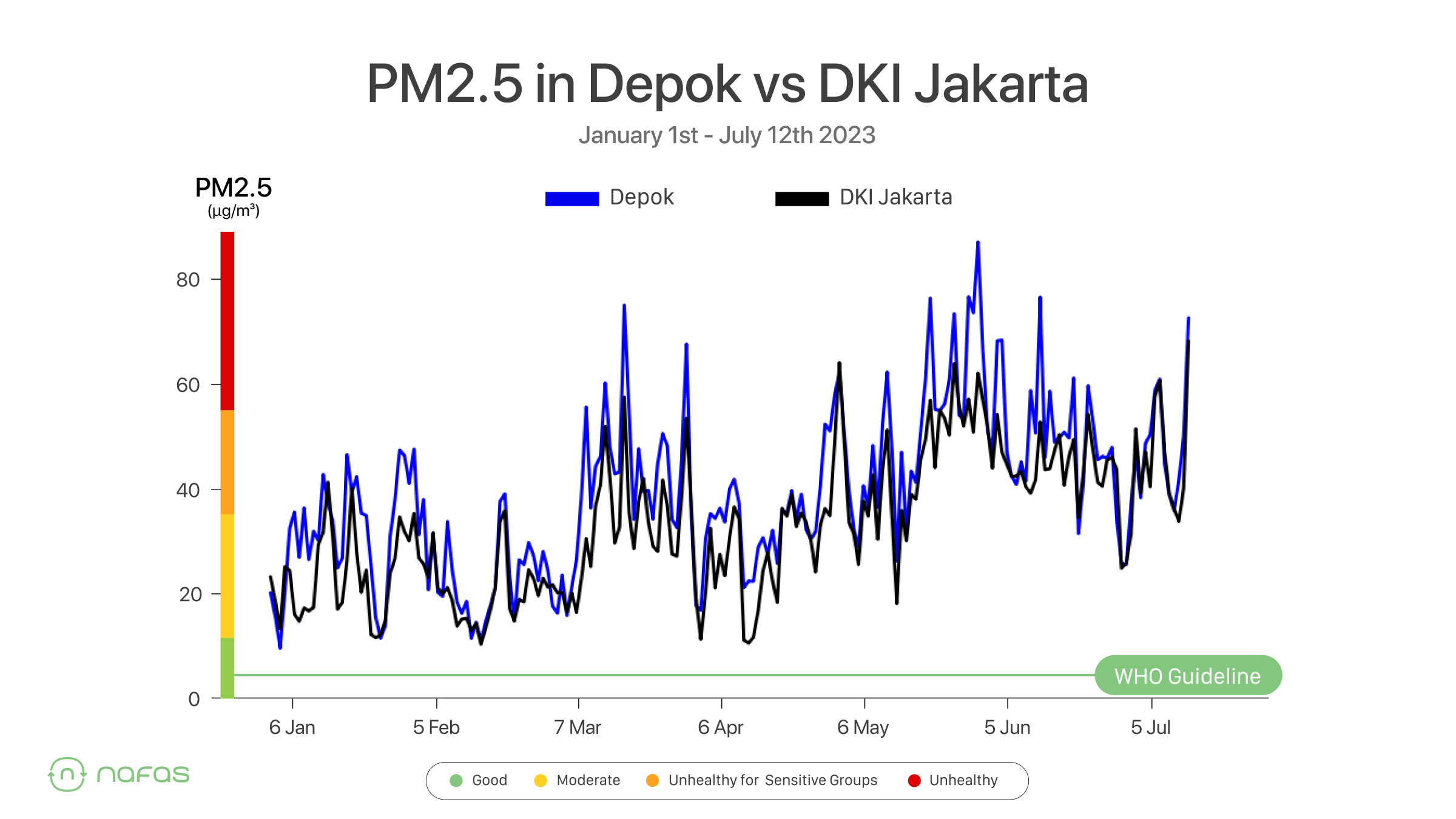Exploring Air Quality of Depok, the City of Phenomenal
Depok, a city near Jakarta, is well known among Indonesians for its unusual 'phenomenal stories'. Once the city with the first Covid-19 case in Indonesia, the location of the world's fiercest thunder, and the city with rumors of 'babi ngepet', does Depok have good and healthy air quality to breathe?
Let's review the air quality in Depok!
The air quality in Depok is as unique as the city itself
Nafas People, let’s take a fresh look at the Nafas sensor distribution below! The image below is the location of the Nafas sensor in Depok, in order from West to East (looking from left to right). This data is from July 1 to 11, 2023.
From the sensor distribution map above, there is one interesting finding about the air quality in Depok: the western part of Depok is more polluted than the eastern part. We can see that areas in the west, such as Bedahan and Grogol for example, are two areas with unhealthy air quality when compared to the eastern Depok area.
From the graphic above, you can see that the air conditions in Bedagan and Grogol in the western part of Depok are unhealthy to breathe, with the amount of PM2.5 reaching 60 ug/m3‼️ However, on the other hand, the further east of Depok, the amount of PM2.5 seems to be less. Limo and Cipayung have moderate air quality.
Air quality in Depok is worse than in DKI Jakarta
The air quality in Depok is 'unique', but not in a good way. Depok's air quality is worse than that of DKI Jakarta. Let's just see the graph below!
The graph depicts the amount of PM2.5 in Depok (blue line) and Jakarta (black line). The air pollution levels look consistently higher than in the capital from January to July 2023.
What's really going on with the air quality in Depok?
Consistently worse than Jakarta, it might make you wonder about the air in Depok being so bad. Below, there is a graph depicting Depok's air quality in June 2023.
It can be seen that almost all areas in Depok have unhealthy air quality on average, except Limo and Cipayung. Moreover, Bedahan is the worst polluted area at 63 µg/m3 or 12x above the WHO annual exposure limit (5 µg/m3), far exceeding DKI Jakarta's average of 43 µg/m3! 😱
This adverse air quality is caused by variations in the local environment, pollution sources (hyperlocal and innate), and the geographical location of different regions.
Now, let's take a more detailed look at the conditions of each region!
Bedahan (the most polluted area)
The image below is the air condition in Bedahan from January to July 2023.
It is evident from the bar graph above that Bedahan's air pollution has been consistently high since January. The air did improve during February, but it got worse and worse until July. May was the worst air quality month in Bedahan, with the highest monthly PM2.5 level reaching 69 µg/m3 (14 times above the WHO annual exposure limit)!
Grogol
Besides Bedahan, check out the air condition in Grogol from January to July 2023!
/image
Keeping the same pattern, it seems that Grogol and Bedahan are 'competitive' when it comes to air pollution levels. This 2023 Breath data shows that almost every month the average air quality in Grogol is unhealthy, with February being the month that has good air quality and May being the month that has the worst air quality.
Cinere
Thirdly, we also want to share the air quality in Cinere from January to July 2023.
When compared to the Bedahan, the air quality in Cinere has the same pattern as it. Fortunately, the air quality in Cinere tends to be better. There were even 3 months in 2023 where the average was quite good, namely January, February, and April.
Depok residents breathe unhealthy air throughout June 2023
During June, Depok residents breathed unhealthy air on average throughout the day, with high pollution levels often occurring in the morning and at night.
Seeing that the air quality tends to be worse in almost all areas of Depok, it is important to be extra careful, especially for pregnant women or parents of young children. Many studies have shown that PM2.5 pollution can cause placental damage, premature birth, and low birth weight (Malley et al., 2017). Another study also showed that there is almost no safe limit for PM2.5 pollution for children. This means that air pollution is really bad for children's health, no matter how small the exposure. ⚠️
In addition, a 2019 study in China showed a 4.3% increase in the number of hospitalizations for children with lower respiratory tract infections for every 10 ug/m3 increase in PM2.5 within 6 days (Xia et al., 2019) 🚩
However, the good thing is that on June 28 to 30, the air quality was quite good consistently from midnight to 2 PM. Just imagine if the air quality in Depok continues to be like this, of course, Nafas people staying in Depok can continue to breathe the air freely and without any worries!
Is there still a way to avoid air pollution?
Unfortunately, we cannot totally avoid air pollution. But preventing ourselves from being exposed to it is certainly possible. The following are tips from the Nafas team to protect ourselves and our children from exposure to air pollution:
- Monitor air quality regularly on the Nafas app
- If the air quality is poor, avoid outdoor activities.
- Always wear a mask when leaving the house. [Dr. Citra Amelinda] "Children over 2 years old can wear a mask (cloth mask or disposable mask) that fits over the nose and mouth." - dr. Citra Amelinda]
- Close doors and windows when air quality is poor. Using an air purifier can help clean the air in the room.